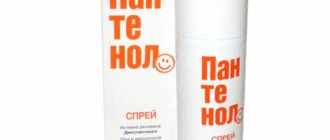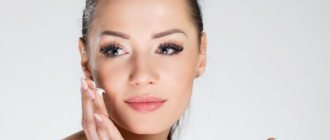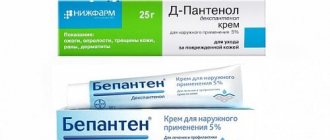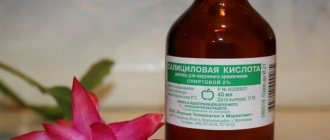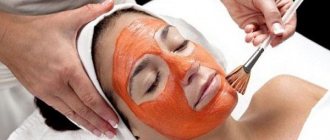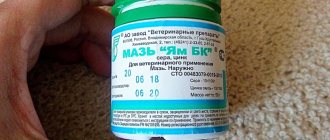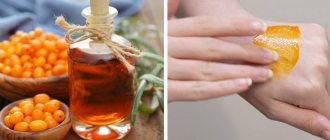Panthenol: composition
The active ingredient in panthenol cream, spray, ointment or balm is called dexpanthenol. The drug is available in different forms (cream, ointment, spray).
!
All these products are suitable for external use only.
Panthenol cream contains 5% active substance (50 mg per 1 g of cream). The remaining share comes from auxiliary components. The cream is produced in tubes of 25 and 50 grams. This is a homogeneous white product with a neutral aroma. Panthenol helps with cracked nipples in nursing women, stretch marks during pregnancy, scars, etc. It is also used for hemorrhoids (Haemorrois) as an aid.
Panthenol ointment also contains 5% of the active ingredient, but differs in the composition of the auxiliary components. It is a homogeneous yellowish substance with the aroma of lanolin. Panthenol ointment is used to treat very dry skin, trophic ulcers, bedsores, and wound surfaces. It is also produced in tubes of 25 and 50 grams.
Panthenol spray with a percentage of 4.63% of the active ingredient is most often used for sunburn. It is produced in aluminum cylinders of 58 and 130 grams.
Are prickly heat and diaper rash in newborns the same thing?
No, these are different diseases. Diaper rash in newborns occurs due to various reasons, and prickly heat, as the name suggests, is only caused by excessive sweating. At the initial stage, prickly heat manifests itself in a similar way - as slight redness of the skin, but then develops into small blisters with clear or cloudy contents.
For a better understanding, find a photo of prickly heat and, for example, diaper rash on a newborn’s bottom - as you will see, they look completely different.
The good news is that there is no need to treat heat rash, you just need to eliminate its causes - overheating of the baby and clogged pores. Traditional methods of preventing diaper rash in newborns, including maintaining the correct temperature in the room, water and air baths, usually eliminate miliaria.
Panthenol: properties for skin
If we talk about how panthenol works for the skin, then first of all we need to mention its regenerative effect. The product promotes rapid restoration of the epidermis. It also gradually reduces inflammation, stabilizes metabolism in cells, and strengthens collagen fibers. In addition, panthenol moisturizes the skin and is an excellent remedy for combating dryness.
For burns, injuries, wounds and various skin diseases, the product compensates for the deficiency of pantothenic acid from which it is produced. When used externally, it is well absorbed. The body converts the drug into pantothenic acid, and then binds it to plasma proteins.
!
The complex effect of panthenol on the skin has led to its demand in cosmetology and medicine.
Creams containing panthenol are used in the treatment of various skin diseases, varicose veins, cosmetic problems, etc. For example, Normaven® Foot Cream, which contains panthenol, has shown good results in the treatment of varicose veins and general improvement in the condition of the skin. This product was developed by highly qualified specialists from a pharmaceutical company, it was tested and was highly appreciated by doctors. The cream has all the necessary documentation and quality certificates and is approved for use by pregnant women. You can buy Normaven® Foot Cream in most pharmacies in the Russian Federation at an affordable price.
Panthenol - application and benefits
For babies
Despite the many advantages of Panthenol, in some cases it is not recommended to use it. This phenomenon is mainly due to the body’s individual intolerance to certain specific substances. For example, this may be increased sensitivity to individual components, or to the drug as a whole.
If there is a suspicion of an inadequate reaction of the body to Panthenol during use, it is better to conduct a test. Apply a small amount to the skin area and leave for a while. If the newborn develops itching or burning, Panthenol is not recommended to be used. In addition, redness and other signs such as rash may appear.
Milk, cream or spray must be applied to cleansed skin. Each new application should be carried out after changing the diaper or swaddling.
Adults are recommended to use the spray. The number of treatments depends on the severity of the disease and skin type. The maximum number of applications per day should not exceed 6 times.
Panthenol: application
Panthenol ointment or cream is applied to the skin (for burns with boiling water, etc.) in a thin layer with previously washed hands. After application, the product must be rubbed in gently. The procedure must be repeated (on average 2–4 times a day, but more often). If panthenol cream, ointment or spray is used for purulent wounds, then an antiseptic treatment must be carried out before this.
The product is also recommended for infants for diaper rash and diaper dermatitis. It is applied to the skin every time after changing diapers and water procedures. Treatment continues until the skin is completely healed.
One of the most common ways to use panthenol moisturizing cream is to treat cracked and inflamed nipples in nursing women. The product is applied to the cracks every time after feeding, without washing it off. Reviews of ointment with panthenol confirm its ability to heal cracks.
Panthenol aerosol with a cooling effect is best suited for healing sun and other burns.
!
Burns are the main indication for the use of this remedy.
The instructions for the drug provide a precise description of how to apply panthenol spray to the skin. The sooner you use it after damage, the better the treatment effect will be. If you choose which is better - panthenol ointment or spray - to use for the treatment of burns, then you should give preference to the spray because of its convenient application.
To treat the surface of the burn, the can is held in a vertical position, shaken first, and then evenly applied to the skin. It is important to ensure that the entire burn is covered with foam. The spray foam is absorbed and has an analgesic and wound-healing effect. The product forms a thin film on the skin: it prevents moisture loss.
The spray must be applied after burns several times, taking into account the degree of damage.
Expert opinion
The most noticeable results are shown by products containing the original dexpanthenol, which cannot be said about cheaper analogues of this product.
Vascular surgeon, phlebologist
Osipova Ekaterina Yakovlevna
Intertrigo
Fungus
Diarrhea
Allergy
Diabetes
Haemorrhoids
23960 November 25
IMPORTANT!
The information in this section cannot be used for self-diagnosis and self-treatment.
In case of pain or other exacerbation of the disease, diagnostic tests should be prescribed only by the attending physician. To make a diagnosis and properly prescribe treatment, you should contact your doctor. Diaper rash: causes of occurrence, what diseases it occurs with, diagnosis and treatment methods.
Definition
Diaper rash is a violation of the integrity of the skin, forming large folds. Diaper rash develops as a result of the irritating and long-term moisturizing effect of skin secretion products (sebum, sweat), as well as friction of the contacting surfaces of the skin.
Diaper rash manifests itself in the form of redness of the skin folds (femoral-scrotal, intergluteal, axillary, under the mammary glands in women, in obese people in the folds of the abdomen, sometimes in the behind-the-ear folds, between the toes and hands).
Subsequently, if treatment is not started, superficial cracks form in the depths of the fold, and detachment of the upper layer of the epidermis occurs (peeling). In advanced cases, painful bleeding ulcerations (erosions) of the affected skin surface, covered with a gray or brown coating, are observed. The patient notes severe burning, pain and itching.
Prolonged diaper rash can turn into eczema, which is accompanied by profuse rashes on the body with the addition of a streptococcal infection or yeast-like fungus. When an infection occurs, an open purulent wound forms at the site of diaper rash. Fungal flora often develops in the interdigital spaces and in the intergluteal fold on the damaged surface.
Diaper rash can appear on the skin of an adult or a bedridden patient, but the skin of newborns is most susceptible to inflammation.
Types of diaper rash
Diaper rash can occur in children and adults. According to the nature of occurrence - infectious and non-infectious.
There are several stages of diaper rash:
- mild – slight redness without compromising the integrity of the skin;
- medium - against the background of reddened skin, minor erosions, microcracks, and sometimes small ulcers are visible;
- severe - in addition to reddened skin and cracks, areas of erosion, ulcers are visible, the epidermis peels off in places. Almost always there is an infection, bacterial or fungal. An extreme manifestation of severe disease is microbial eczema, in which lesions are aggravated by an autoimmune process.
Diaper rash can be:
- diaper room,
- impetigo (appears in the groin area),
- allergy ring (to food and hygiene products).
The most common types of diaper rash are:
- weeping;
- diabetic, occurring mainly in the inguinal and femoral folds, under the mammary glands and in the armpits;
- seborrheic, occurring behind the ears, on the neck, in the armpits, inguinal folds and in the navel;
- streptococcal;
- fungal;
- under plaster;
- between the buttocks;
- on the feet and legs;
- umbilical
Possible causes of diaper rash
The main cause of diaper rash is increased moisture in the skin in the area of natural folds and exposure to irritating chemical components. In other words, for diaper rash to appear, favorable conditions must be created that increase the vulnerability of the skin even with minor mechanical impact (friction).
Feces contain enzymes (protease and lipase) that literally eat away the skin, so with diarrhea, diaper rash often develops within a few hours.
Diaper rash in newborns can occur for various reasons, such as friction or constant wetness under the diaper. But the main factor is skin contact with urine and feces.
Ammonia, which is formed during the breakdown of urea, has an irritating effect on the delicate skin of the child.
Feces are acidic. If the baby suffers from diarrhea, this also leads to diaper rash.
Causes of diaper rash in children:
- poor quality diapers;
- rare diaper changes;
- careless wiping of the child’s body after water procedures;
- wrapping the baby too tightly;
- high indoor air temperature.
An allergic predisposition significantly increases the risk of developing diaper rash.
In newborns and infants up to one year old, an allergic reaction to the mother's food, baby food, hygiene products, the appearance of new foods in the child's diet, antibiotic treatment of the baby or mother can also contribute to the appearance of diaper rash. Another important factor is the individual characteristics of children's skin: if a baby has hypersensitive skin, then the risk of diaper rash increases significantly.
Causes of diaper rash in adults:
- poor air ventilation in the area of skin folds;
- increased sweating;
- diabetes mellitus and other endocrine disorders; e
- overweight, obesity;
- involuntary urination;
- allergic reactions;
- skin infections;
- haemorrhoids;
- discharge from fistulas and natural anatomical openings in seriously ill patients;
- violation of basic hygiene rules, insufficient drying of skin folds after bathing.
In older people, the production of elastin and collagen decreases, which affects the condition of the skin, leading to dryness, thinning, and loss of elasticity.
The skin is easily injured, becomes cracked and inflamed. Which doctors should I contact for diaper rash?
Treatment is carried out by a dermatologist or general practitioner on an outpatient basis. If diaper rash appears in a child, you should consult a pediatrician; in difficult cases, a pediatric dermatologist is involved in treatment.
Diagnostics and examinations for diaper rash
The diagnosis is made on the basis of the clinical picture - the location of the lesion and the appearance of the affected areas of the skin. The patient's complaints and objective examination data are taken into account. If necessary, smears are taken from the affected skin surface for subsequent bacteriological examination.
Panthenol: indications for use
Panthenol is a universal drug that is used to restore skin for injuries, burns, inflammatory diseases, varicose veins, etc. It helps to quickly heal the skin for all kinds of abrasions and cuts, dermatitis (Dermatitis), cracks, bedsores and trophic ulcers. For cosmetic purposes, the product can be used to protect against dry skin as a result of exposure to wind, frost, etc.
Indications for use panthenol
The ointment can be used on open wounds. It is also used to speed up healing during skin grafting. In addition, panthenol is widely used in cosmetics. Dry skin is treated with products containing it.
